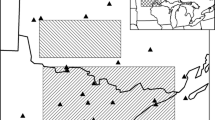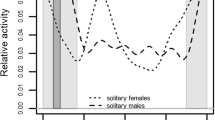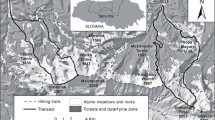Summary
A set of concepts was presented which could be used to model an animal's activity cycle and habitat choice as an optimization process. The model was applied to moose (Alces alces) summer activity and its predictions were consistent with observed feeding times and habitat selections. The optimization model had a goal of maximizing daily feeding time at the least possible energetic cost. This goal was consistent with a foraging strategy that maximized the intake of some nutritional component, i.e. energy, protein, etc. The optimization problem, however, was bounded. Three constraints appeared to limit the goal: body temperature must be maintained within set upper and lower limits, thermal equilibrium must be maintained over an extended period so the activity cycle strategy can be repeated and sufficient time must be spent ruminating.
Similar content being viewed by others
References
Bellman RE, Dreyfus SE (1962) Applied dynamic programming. Princeton New Jersey Princeton Univ Press
Belovsky GE (1978) Diet optimization in a generalist herbivore: the moose. Theor Pop Biol 14:105–134
Belovsky GE, Jordan PA (1978) The time-energy budget of a moose. Theor Pop Biol 14:76–104
Blaxter KL (1962) The energy metabolism of ruminants. Hutchinson Ltd. London
Blaxter KL, Wainman JW (1961) Envionmental temperature and the energy metabolism and heat emission of steers. J Agric Sci 56:81
Brockway JM, Maloiy GMO (1968) Energy metabolism of the red deer. J Physiol 194:22–24
Cena K, Clark JA (1973) Thermal radiation from animal coats: coat structure and measurements of radiative temperature. Phys Med Biol 18:432–443
DeWitt CB (1968) Precision of thermoregulation and its relation to environmental factors in the desert iguana, Dipsosaurus dorsalis. Physiol Zool. 40:19–66
Finch VA (1972a) Thermoregulation and heat balance of the East African eland and hartebeest. Amer J Physiol 222:1374–1379
Finch VA (1972b) Energy exchanges with the environment of two African antelopes, the eland and the hartebeest. Symp Zool Soc Oondon 31:315–326
Gates DM (1969) Infrared measurement of plant and animal surface temperature and their interpretation. In: P.L. Johnson (ed) Remote sensing in ecology. Athens Georgia Univ of Georgia Press, p 95–107
Gordon MS, Bartholomew GA, Grinnel AD, Jørgensen CB, White FN (1968) Animal function: principles and adaptation. London: Mac-Millan Co
Heath JE (1964) Reptilian thermoregulation: evaluations of field studies. Science 146:784–785
Huey R, Slatkin M (1976) Costs and benefits of lizard thermoregulation. Quart Rev Biol 51:363–384
Irving L (1964) Terrestrial animals in cold: birds and mammals. In: Handbook of physiology DB Dill (ed), Sec 4 Washington DC.: Amer Physiol Soc p 361–378
Kleiber M (1961) The fire of life. John Wiley, New York
Knorre EP (1959) Ecology of the moose. Trans of the Pechora-Illych State Game Preserve, U.S.S.R. GA Novikow (ed). (Translated from the Russian by the Canadian Bureau of Indian Affairs) Syktyvkar, USSR Komi Book Publishers
Lull HW, Reigner IC (1967) Radiation measurements: by various instruments in the open and in the forest. US Forest Serv Res Pap NE-84
Mitchell JW (1976) Heat transfer from spheres and other animal forms. Biophys J 16:561–569
Moen A (1973) Wildlife ecology. San Francsico: WH Freeman Co
Monteith JL (1973) Principles of environmental physics. American Elsevier Publishing Co, Inc. New York
Morhardt SS (1975) Use of climate diagrams to describe microhabitats occupied by Belding ground squirrels and to predict rates of change of body temperature. In: Perspectives in biophysical ecology (eds) Gates D, Schmerl RB. Springer-Verlag, Berlin Heidelberg New York p 303–324
Morhardt SS, Gates D (1974) Energy-exchange analysis of the belding ground squirrel and its habitat. Ecol Mono 44:17–44
Peterson RL (1955) North American moose. Toronto: Univ of Toronto Press
Porter WP, Gates D (1969) Thermodynamic equilibria of animals with environment. Ecol Mono 39:227–244
Porter WP, Mitchell JW, Beckman WA, DeWitt CB (1973) Behavioral implications of mechanistic ecology: thermal and behavioral modelling of desert ectotherms and their microenvironment. Oecologia (Berl) 13:1–54
Porter WP, Mitchell JW, Beckman WA, Tracy CR (1975) Environmental constraints on some predator-prey interactions. In: D Gates, RB Schmerl (eds) Perspectives in biophysical ecology. Springer-Verlag, Berlin Heidelberg New York p 347–364
Pyke GH, Pulliam HR, Charnov EL (1977) Optimal foraging: a selective review of theory and tests. Quart Rev Biol 55:137–154
Riemerschmid G, Elder JS (1945) The absorptivity for solar radiation of different coloured hairy coats of cattle. Onderstepoort J Vet Sci Animal Ind 20:223–234
Schmidt-Nielsen K (1975) Animal physiology: adaptation and environment. London: Cambridge Univ Press
Schoener TW (1969) Optimal size and specialization in constant and fluctuating environments: an energy-time approach. Brookhaven Symp Biol 22:103–114
Schoener TW (1971) Theory of feeding strategies. Ann Rev Ecol Syst 2:369–403
Schoener TW (1974) The compression hypothesis and temporal resource partitioning. Proc Nat Acad Sci 71:4169–4172
Sellers WD (1965) Physical climatology. Chicago: Univ of Chicago
Silver H, Holter JB, Colovos HF, Hayes HH (1971) Effect of falling temperature on heat production in fasting white-tailed deer. J Wildl Manage 35:37–46
Weiner J (1977) Energy metabolism of the roe deer. Acta Theriol 22:3–24
Whittow GC (1971) Ungulates. In: G.C. Whittow (ed) Comparative physiology of thermoregulation. Academic Press, New York. p 192–283
Author information
Authors and Affiliations
Rights and permissions
About this article
Cite this article
Belovsky, G.E. Optimal activity times and habitat choice of moose. Oecologia 48, 22–30 (1981). https://doi.org/10.1007/BF00346984
Received:
Issue Date:
DOI: https://doi.org/10.1007/BF00346984




